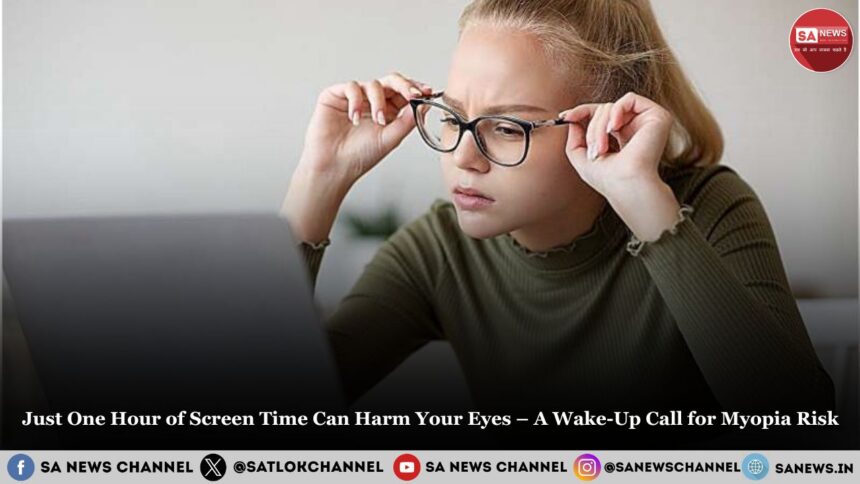Be honest—how many hours do you spend looking at a screen each day?
If you’re like most people, your screen time adds up fast whether it’s scrolling social media, binge-watching shows, working on a laptop, or gaming. But what if you knew that spending just one hour on a screen daily could increase your risk of myopia (nearsightedness) by 21%?
Sounds alarming, right? But that’s exactly what a recent South Korean study found.
With screens being an unavoidable part of life, we must understand the risks and use technology more responsibly.
What Is Myopia?
Ever squinted at a road sign or struggled to see things far away while your phone screen remained crystal clear? That’s myopia (nearsightedness).
It happens when the eyeball grows too long, or the cornea curves too much, making distant objects look blurry.
The real problem? Once myopia develops, it doesn’t go away. If it worsens, it can lead to retinal detachment, glaucoma, and even blindness in extreme cases.
And here’s the shocking part—by 2050, nearly half of the world’s population is expected to be nearsighted.
What Did the South Korean Study Find?
Researchers in South Korea analyzed data from over 335,000 people and discovered:
For every additional hour of screen time per day, the risk of developing myopia increased by 21%.
The most dangerous period? Between one and four hours of daily screen use.
After four hours, the risk still rises but at a slower rate.
This means that keeping screen time below one hour daily might help prevent or delay myopia—a difficult challenge in today’s digital world.
Why Does Too Much Screen Time Harm Your Eyes?
1️⃣ Your Eyes Aren’t Designed for Constant “Close-Up” Focus
Staring at screens for hours strains the eye muscles and gradually alters the shape of your eyeball—leading to myopia.
2️⃣ Less Outdoor Time = Higher Risk
Natural light is essential for healthy vision. Studies show that spending at least two hours outdoors daily can significantly reduce myopia risk.
3️⃣ Digital Eye Strain Is Real
Ever felt burning, itching, or dry eyes after prolonged screen use? That’s digital eye strain, caused by reduced blinking and screen glare.
Who’s Most at Risk?
- Children & Teenagers – Their developing eyes are highly sensitive to prolonged screen exposure. Increased online learning, gaming, and social media usage have led to a global rise in myopia cases.
- Working Professionals – Adults who spend long hours on digital devices for work are also at high risk.
The study’s findings emphasize the urgent need for better screen habits and eye care strategies.
How to Protect Your Eyes from Screen-Induced Myopia
✅ Follow the 20-20-20 Rule – Every 20 minutes, look at something 20 feet away for 20 seconds. This simple habit reduces eye strain.
✅ Get More Outdoor Time – Aim for at least two hours of natural daylight daily to help maintain healthy vision.
✅ Limit Recreational Screen Time – Swap excessive screen time for reading, walking, or hobbies that don’t involve screens.
✅ Adjust Your Screen Settings – Use blue light filters, increase text size, and maintain proper brightness to reduce strain.
✅ Blink More – Blinking keeps your eyes moist and comfortable—something most people forget while staring at screens.
✅ Get Regular Eye Checkups – Detecting vision issues early prevents long-term damage. A simple eye exam can save your sight.
Are Screens Controlling Us?
Technology is a powerful tool but are we using it for the right reasons?
The South Korean study is a wake-up call. If just one hour of screen time can increase myopia risk, imagine the impact of four or five hours daily.
Technology should serve us not control us. Let’s use it wisely for healthier eyes, meaningful knowledge, and true spiritual growth.
Will you take control of your screen habits today? Your eyes and your soul will thank you.
Sant Rampal Ji Maharaj’s Perspective on Technology
Sant Rampal Ji Maharaj teaches that technology should serve humanity, not enslave it.
Most people spend hours on social media, watching videos, or chasing material success, yet still feel empty.
True happiness isn’t found in endless distractions, it comes from understanding life’s real purpose and seeking true spiritual knowledge.
Modern technology should be used to spread truth, reduce suffering, and connect people with the Supreme God Kabir. Instead of wasting time on temporary digital pleasures, we should use technology to discover the eternal truth about our existence.
If we choose wisely, technology can be a tool for spiritual awakening not just entertainment.
FAQs about Myopia
1. How does screen time increase myopia risk?
Excessive screen use strains the eyes, forcing them to focus on close objects for long periods. Over time, this changes the shape of the eyeball, leading to myopia.
2. What did the South Korean study reveal?
The study found that for every extra hour of screen time daily, myopia risk increases by 21%—with the highest risk between one to four hours of daily screen exposure.
3. How does outdoor time help prevent myopia?
Spending at least two hours outdoors daily provides natural light that regulates eye growth and reduces the risk of myopia.
4. What is the 20-20-20 rule?
It’s a simple eye exercise: every 20 minutes, look at something 20 feet away for 20 seconds. This relieves eye strain caused by prolonged screen use.
5. What does Sant Rampal Ji Maharaj say about technology?
He teaches that technology should be used to spread true spiritual knowledge—not as a tool for distraction. It should help people understand the true purpose of life and connect with Supreme God Kabir.









